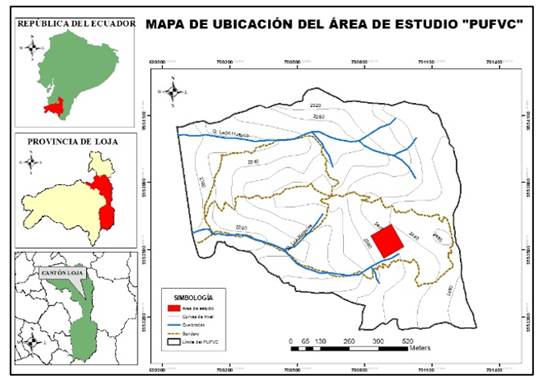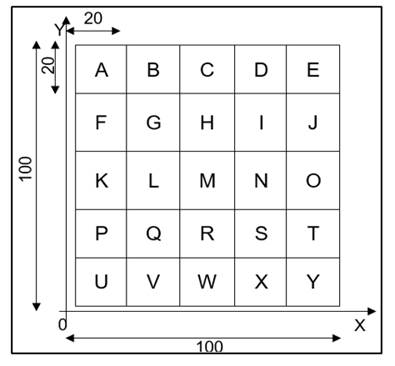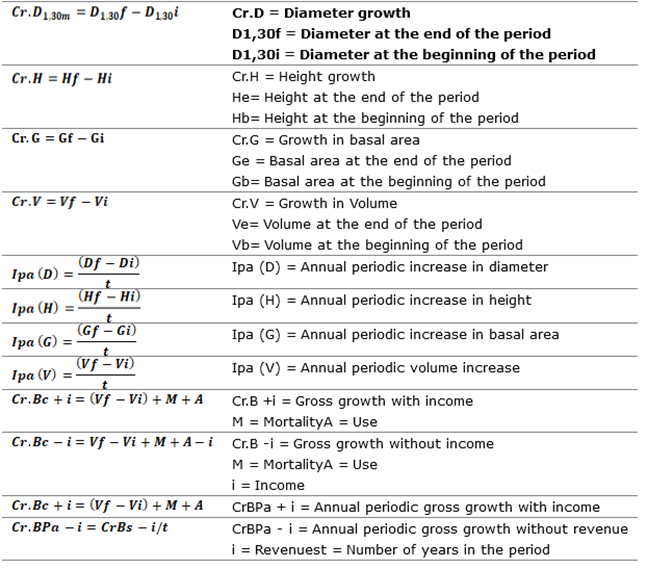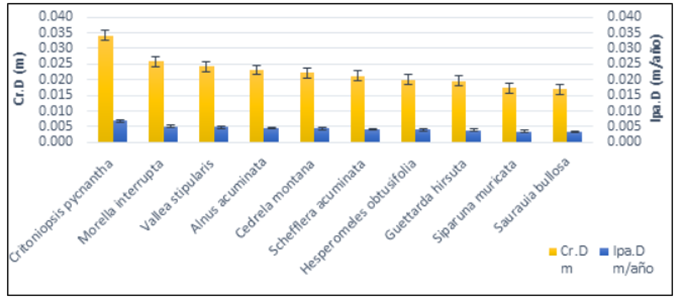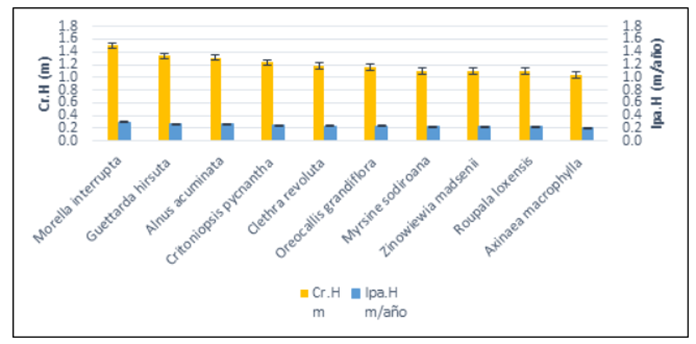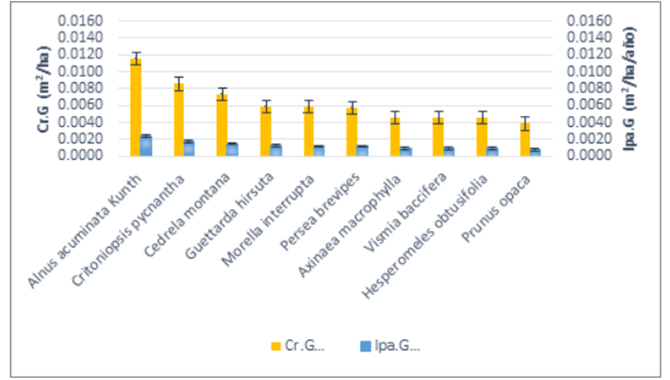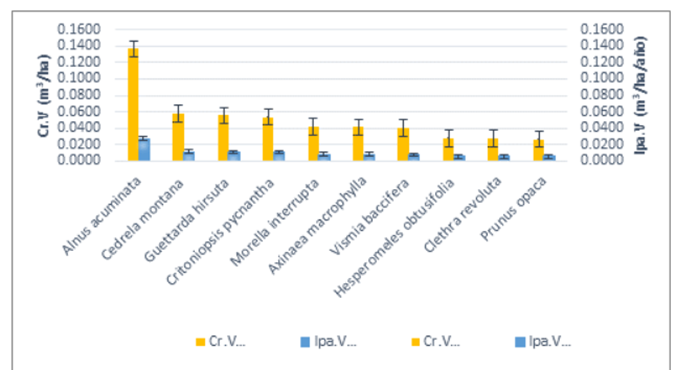Revista Cubana de Ciencias Forestales
ISSN 2310-3469
02--2022
Original article
Growth dynamics of forest species in the Andean forest of the "Francisco Vivar Castro" University Park, Loja, Ecuador
1Universidad Nacional de Loja. Ecuador.
2Libre ejercicio profesional Ecuador.
3Universidad de Pinar del Río "Hermanos Saíz Montes de Oca". Pinar del Río, Cuba.
The ecological processes of the vegetation provide valuable information for its management. The research was carried out with the purpose of determining the dynamism and growth of forest species in the Andean forest in the Loja basin, Ecuador, over a period of five years. Work was carried out in a permanent plot of 100 x 100 m2 installed in 2017. The new measurement of D 1.30 m and total height of the woody individuals registered in 2017 and of those that have entered was made. The new plants were labeled and a red ring was painted where the D 1.30 m was measured. The dynamism was calculated based on mortality and recruitment, growth and annual periodic increase in diameter, height, basal area and volume. By 2022, 1,214 individuals of 44 species, 38 genera, and 29 families have been recorded; the mortality rate is 4.68 % and the recruitment rate is 0.13 %, with an annual dynamism of 2.41 %. The average growth in diameter is 0.0137 ± 0.0021 m, in height is 0.8 ± 0.1 m, in basal area is 0.0028 ± 0.0004 m2 ha-1 and in volume is 0.020 ± 0.003 m 3 ha-1. The species with the highest average diameter growth is Critoniopsis pycnantha, in height it is Morrela interrupta, in basal area and volume Alnus acuminata. The Andean forests of the Loja basin are dynamic, there are more deaths than recruitments. They have uniform growth, and also, species that grow more than others.
Key words: Andean forest; Dynamism; Recruitment; Mortality; Growth and increment.
INTRODUCTION
Ecuador is a mega-diverse country, with 92 ecosystems and part of this wealth is the Andean forests, which grow between 2,000 and 3,200 meters above sea level. Trees are the most distinguished elements and represent the largest amount of forest biomass and store a large amount of carbon, provide wood, fruits, resins, latex, fibers, scenic beauty, soil protection against erosion and other essentials that help maintain the water regime (García, 2014).
The Andean forest is a highly threatened ecosystem in Ecuador, due to the tendency of human beings on the conversion of use to carry out agricultural and livestock activities, selective deforestation to obtain carbon and extraction of Non-Timber and Timber Forest Products in an unsustained manner (Bussmann, 2005). And there are still knowledge gaps about its dynamics, which makes it difficult to establish actions for its management and conservation. In addition, considering that in some Andean areas of the southern region of the country there are patches of primary forest resulting from anthropic activity (Jadan et al., 2017), it is important to study the dynamics of these last forest remnants.
Dynamics is defined as an orderly process of changes in vegetation, in which the forest can be measured by three indicators: growth of stands and tree species, mortality rate and recruitment rate. The dynamism of the forest is expressed by the changes derived from the mortality and recruitment of individuals over the years (Restrepo et al., 2016). It is also important to know the natural regeneration that occurs in the forest species through monitoring plots that can directly obtain the diameter and height of the trees, calculate the basal area or biomass, and thus understand the natural forest processes (Torres et al., 2012).
The knowledge of growth dynamics of forest species and forests is valuable, since the technical-scientific bases established, allow forest promotion, conservation and management. Therefore, it is necessary to investigate; it urges to understand the behavior of the species and plan their management and conservation. In addition to the constant change in the number of individuals, it is also significant to be aware of the disappearing species to make way for new ones in the natural process of succession.
Furthermore, considering that the purpose of the National University of Loja and its institutional projects is to have scenarios for future professionals to engage in their activities, this article is the result of using the scenarios of the institutional project called: Ecological Processes of the vegetation in the "Francisco Vivar Castro" University Park, National University of Loja. Phase III. 2022-2023, which took place between April and September 2022, with the objective of determining the dynamism and growth of forest species in the Andean forest in the Loja basin in the province of Loja.
MATERIALS AND METHODS
Location of the study area
The study was carried out in a permanent plot located in the "Francisco Vivar Castro" University Park (PUFVC), in the Loja basin, San Sebastián parish, Loja canton, Loja province. The permanent quadrant of one hectare is located between the UTM coordinates: 700 592 9 554 223 N, 700 970 9 553 139 S 701 309 9 553 171 E, 699 961 9 554 049 W. Figure 1 shows observes the location of the PUFVC at the cantonal, provincial and national levels. The PUFVC is found between 2 130 and 2 520 m asl, with an annual rainfall of 955 mm; average annual temperature of 16.6 ºC; and average evaporation of 111.33 mm (Aguirre et al., 2016).
Description of the permanent plot
The permanent plot of 1 ha (100 x 100 m) evaluated was established by Reyes in 2017, it is located in a fragment of Andean forest within the PUFVC, in the Loja basin, it is subdivided into 25 subplots of 20 x 20 m. The distribution design of the subplots is shown in Figure 2.
Collection of data of arboreal individuals greater than 5 cm of D1.30 m
The new remeasurement of all the tree individuals registered in the first measurement of the year 2017 was carried out; and the D1.30 m and total height of the admitted or recruited individuals who have a D1.30 m greater than 5 cm in the year 2022 were measured.
Determination of the dynamism of tree species
The number of living individuals identified and registered in 2017 was counted, as well as the appearance of other individuals with D1.30 m greater than 5 cm until the year 2022. With the data, mortality and recruitment rates were calculated using the formulas proposed by Condit et al. (1999) and Marin et al. (2005) (Equation 1; Equation 2; Equation 3).
Average annual increase of forest species
For this research, the database of the year 2017 and the measurements of the year 2022 were considered. The average annual growth and increase of D1.30 m, total height, basal area and volume were calculated (for the calculations of each variable, the average values of each species) considering the data of the first measurement and the second measurement. The formulas proposed by Quesada et al. (2012) and the standard error was calculated for the results obtained (Table 1).
RESULTS
Dynamism of the Andean forest of the PUFVC in the period 2017 - 2022
By the year 2022, 1,214 individuals were registered, of 44 species corresponding to 38 genera of 29 families, which means that the mortality rate is 4.68 % and the recruitment rate is 0.13 % (Table 2).
Average growth and annual periodic diameter increase in diameter
In five years, there was an average diameter growth of 0.0137 ± 0.0021 m and a periodic annual increase of 0.0027 m year-1. The three species with the highest growth and average increase in diameter are: Critoniopsis pycnantha that presents 0.0341 ± 0.0051 m of average diameter growth and an annual periodic increase of 0.0068 m year-1; Morella interrupts with 0.0258 ± 0.0039 m and 0.0052 m yr-1 ; and Valley stipularis with 0.0242 ± 0.0036 m and 0.0048 m ha-1 year-1. Meriania tomentosa and Myrsine sodiroana showed a growth and increase of 0.0041 ± 0.0006 m with 0.0008 m year-1 and 0.0033 ± 0.0007 m with 0.0007 m year-1 respectively. Figure 3 shows the 10 species with the highest average growth and periodic annual increase in diameter (Figure 3).
Average growth and annual periodic diameter increase in height
The species showed an average growth in height of 0.8 ± 0.1 m with an average annual periodic increase of 0.17 m year-1. The species with the highest average growth in height is Morella interrupta , which has an average growth of 1.5 ± 0.2 m and an average annual periodic increase of 0.30 m year-1, followed by Guettarda hirsuta with an average growth of 1, 3 ± 0.2 m and an average annual periodic increase of 0.27 m year -1 and Alnus acuminata with 1.3 ± 0.2 m and 0.26 m yr-1 of average growth and average annual periodic increase, respectively. Figure 4 shows the 10 species with the highest average growth and periodic annual increase over a five-year period (Figure 4).
Average growth and annual periodic diameter increase in basal area
Between 2017 and 2022, the species had an average growth in basal area of 0.0028 ± 0.0004 m2 and an average annual periodic increase of 0.0006 m2 ha-1 year-1 . The three species with the highest average growth and increase in basal area are Alnus acuminata with 51 ind. ha-1 presents 0.0116 ± 0.0018 m2 of average growth in the basal area and a periodic annual increase of 0.0023 m 2 ha -1 year-1, followed by Critoniopsis pycnantha, with 6 ind . ha-1, 0.0086 ± 0.0013 m2 and 0.0017 m 2 ha-1 year-1; and Cedrela montana, with 11 ind. ha-1 0.0073 ± 0.0011 m2 and 0.0015 m2 ha-1 year-1. On the contrary, Meriania tomentosa and Monnina hirta showed low growth and increment with values of 0.0005 ± 0.0001 m 2 with 0.0001 m2 /ha/year and 0.0004 ± 0.0001 m2 with 0.0001 m2 ha-1 year-1 respectively. Figure 5 shows the 10 species with the highest average growth and annual periodic increase in basal area (Figure 5).
Average growth and annual periodic diameter increase in volume
The species of the Andean forest of the PUFVC, during a period of five years had an average volume growth of 0.020 ± 0.003 m3 and a periodic annual increase of 0.004 m3 ha-1 year-1. Alnus acuminatawith 51 individuals. ha-1 has an average growth of 0.137 ± 0.021 m 3 ha-1 and annual periodic increase of 0.027 m3 ha-1 year-1, followed by Cedrela montana with 11 individuals. ha-1 with a growth of 0.057 ± 0.009 m 3 ha-1 and periodic annual increase of 0.011 m3 ha-1 year-1 and Guettarda hirtusa with 8 individuals. ha-1 with 0.055 ± 0.008 m3 ha-1 and 0.011 m 3 ha-1 year1 of annual periodic increase. The species with the lowest average volumetric growth are Myrsine depend and Monnina hirta with 1 ind. ha-1 each species, given a growth of 0.003 ± 0.0001 m3 ha-1 and 0.002 ± 0.0001 m3 ha-1 respectively (Figure 6).
Periodic gross growth with and without income
In 2017, 1,370 individuals were documented in the permanent plot. ha-1 with a volume of 77.57 m3 ha-1. In the year 2022 1 214 ind. ha-1, which add up to a volume of 93.26 m3 ha-1 where the volume of 130 recruited individuals is included (1.65 m3 ha-1), the volume of 286 dead individuals is excluded (10.99 m3 ha-1 ). Table 3 summarizes the values obtained from the growth and increase of the different variables of the permanent plot during the evaluation period of five years.
Table 3. - Average growth and periodic annual increase of the dasometric and volumetric variables analyzed in the permanent plot of the PUFVC in the period 2017-2022
| Parameters | Value obtained | unit of measure |
|---|---|---|
| Average growth in diameter | 0.0137 ± 0.0021 | m ha -1 |
| Average growth in height | 0.8 ± 0.1 | m ha -1 |
| Average growth in basal area | 0.0028 ± 0.0004 | m 2 ha -1 |
| Average growth in volume | 0.020 ± 0.003 | m 3 ha -1 |
| Annual periodic increase in diameter | 0.0027 | m ha -1 year -1 |
| Annual periodic increase in height | 0.17 | m ha -1 year -1 |
| Annual periodic increase in basal area | 0.001 | m 2 ha -1 year -1 |
| Annual periodic increase in volume | 0.004 | m 3 ha -1 year -1 |
| Gross forest growth with income | 26.68 | m 3 ha -1 |
| Gross forest growth without income | 25.04 | m 3 ha -1 |
| Annual periodic gross growth of the forest with income | 5.34 | m 3 ha -1 year -1 |
| Gross annual periodic forest growth without income | 5.01 | m 3 ha -1 year -1 |
DISCUSSION
Floristic composition in the permanent plot of the Andean forest of the "Francisco Vivar Castro" University Park
In the year 2022, 1,214 individuals ≥ 5 cm DBH were registered, corresponding to 44 species, 38 genera, and 29 families, with the Rubiaceae and Urticacea families being the most diverse, and the Palicourea and Phenax generasthe most abundant. Data similar to those reported by Aguirre et al. (2021) that the Huashapamba forest in Saraguro in a permanent plot of one hectare, is 54 species, 39 genera and 27 families; but different from studies of population dynamics in the Cajanuma cloud forest carried out by Sánchez and Rosales (2002), where 2 080 individuals/ha were recorded, belonging to 80 species, 47 genera and 30 families. Also the results of this research are similar to Aguirre et al. (2021) that for the Andean forest of the Santiago parish, they inventoried the woody elements greater than 5 cm of D1.30 m , and report 1 793 individuals of 68 species and 42 genera in 33 families, compared to these studies the floristic composition of the Andean forest of the "Francisco Vivar Castro" University Park is low, possibly due to the fact that it is a remnant forest in recovery.
Dynamism based on recruitment and mortality in the permanent plot of the Andean forest of the "Francisco Vivar Castro" University Park
The mortality rate (4.68 %) is higher than the recruitment rate (0.13 %), because of the death of individuals during landslides, crushing due to fall of large trees and other numerous causes. Those events alter the structure and composition of the Andean forest of the PUFVC.
The mortality of the woody component of the Andean forest of the "Francisco Vivar Castro" University Park in a period of 5 years is high, according to the 286 dead individuals, which corresponds to 4.68 %. This value differs from the results reported by Aguilar and Reynel (2011) in the cloud forest of Peru, where an annual mortality rate of 1.07 % was obtained. It also differs from those obtained by González and Pardo (2013) in El Padmi , where a mortality of 60 individuals was registered which represents 1.6 % in a period of four years.
Regarding recruitment (income), 130 individuals were documented, corresponding to 0.13%. This value differs from that reported by Aguilar and Reynel (2011) in the Andean forest of Peru in a permanent plot of one hectare, where the annual rate of recruitment was 2.94 % because the study area is subject to natural disturbances and has a high recruitment capacity. That is different to what González and Pardo (2013) indicate with a recruitment of 70 individuals in a period of 4 years that represents 1.9 %; likewise, Monge et al. (2012) obtained a recruitment rate of 1.87 % over a period of 19 years in the tropical humid forest of Costa Rica.
The annual rate of dynamism of the forest in the 5-year period is 2.41 % per year, which is similar to that obtained by Quezada (2019) in the Tapichalaca cloud forest, where he obtained a dynamism of 0.0269, which represents 2, 69 % per year. At the same time is similar to the study carried out by Sánchez and Rosales (2002) who indicate that the Cajanuma forest is highly dynamic with rates of change (mortality + recruitment) of 2.05 % per year. Besides, it is similar to the study carried out by González and Pardo (2013) in the Quebrada El Padmi plot, in the period 2008-2012, where a dynamism of 2.5 % per year was recorded.
Periodic annual growth of the species in the permanent plot of the Andean forest of the "Francisco Vivar Castro" University Park
In this regard, there are data reported by Aguirre et al. (2016) of a permanent plot of one hectare in the seasonal dry forest of Algodonal, Macará canton, province of Loja, where an average diameter growth of 1.63 cm ha-1 , in height 2.33 m ha-1 is reported 1, with a basal area of 0.0065 m2 ha-1 and a volumetric area of 0.0683 m3 ha-1; a similar result to that of this study in terms of diametric growth (1.4 cm ha-1 ), basal area (0.003 m 2 ha-1) and differs in volumetric growth (0.020 m3 ha-1).
The species of the Andean forest of the PUFVC during a period of five years had an average growth in diameter of 0.0137 ± 0.0021 and a periodic annual increase of 0.0027 m ha-1 year-1. The species with the highest average diameter growth is Critonipsis pycnantha, followed by Morella interrupta and Vallea stipularis, these diameter increase values are similar to those presented by Quezada (2019), who reports an average diameter increase in the ten-year period of 0.0303 ± 0.0144 m ha-1. However, the recorded species differ, such is the case of Guarea pterorhachis (0.005 ± 0.0248 m ha-1), Croton lechleri (0.0534 ± 0.0448 m ha-1) and Aparisthmiun cordatum (0.0528 ± 0.0353 m ha-1), Palicourea amethystine (0.0159 ± 0.009 m ha-1) shows similar growth. The species that show the best growth seem to be due to the fact that they are species with low wood density. While Myrsine sodiroana is the species with the lowest annual periodic diameter increase (0.001 m year-1) in the Andean forest of the PUFVC, similar to those reported by Quezada (2019) in Tapichalaca, where it is also one of the species with the lowest increase (0.018).
The woody component of the PUFVC shows an average growth in height of 0.8 ± 0.1 m ha-1, in basal area of 0.0028 ± 0.0004 m2 ha-1 and in volume of 0.020 ± 0.003 m3 ha-1; These results fluctuate from those presented by González and Pardo (2013) in the experimental farm "El Padmi" where they report an average growth in height of 0.1965 m/year, basal area of 0.1403 cm2 year-1 and they resemble in volumetric growth (0.0130 m3 year-1). They also vary from those reported by Quezada (2019) where the forest species of the cloud forest of the Tapichalaca nature reserve in Zamora Chinchipe show a growth in basal area of 0.0139 ± 0.0125 m2 ha-1 and in volume of 0.1630 ± 0.1841 m3 ha-1.
Periodic annual increase of the species in the permanent plot of the Andean forest of the "Francisco Vivar Castro" University Park
The woody component of the Andean forest presented a periodic annual increase in diameter of 0.0027 m ha-1 year-1 and in basal area 0.001 m2 ha-1 year-1. These results are very similar in diameter but differ in basal area to those reported for the cloudy Andean forest of the central jungle of Peru (Aguilar and Reynel, 2011), who recorded an average diameter increase in the period of 3 years and 7 months of 0.37 cm year-1 and an increase in area baseline of 3.42 m2 ha-1 year-1.
The gross growth with and without income during a five-year period of the Andean forest of the PUFVC obtained is 26.68 m3 ha-1 and 25.04 m3 ha-1 respectively, it is similar to that reported by Quezada (2019) considering a period of ten years in the cloud forest in the Tapichalaca Reserve, a gross growth with income of 56.67 m3 ha-1 and without income 47.77 m 3 ha -1.
CONCLUSIONS
The Andean forest of the PUFVC, in a period of five years (2017-2022) has a mortality rate of 4.68 %, a recruitment of 0.13 % with an annual dynamism rate of 2.41.
The Andean forest had a gross growth with income of 26.68 m3 ha-1, with an annual periodic gross growth with income of 5.34 m3 ha-1 year-1; the gross growth of the forest without income is 25.04 m3 ha1, for an annual periodic gross growth of the forest without income of 5.01 m3 ha-1 year-1.
The volume values (112.71 m3 ha-1) and gross growth (26.68 m3 ha-1) show that functional processes related to the development of the forest mass have not been highly disturbed.
The Andean forests of the Loja basin are dynamic, there are more deaths than recruitments and they have uniform and irregular growth between species due to factors such as the fall of large trees, the topography of the land, mass landslides and the natural death of some individuals especially of the pioneer and intermediate species.
REFERENCES
AGUILAR, M., & REYNEL, C. 2011. Dinámica forestal y regeneración en un bosque montano nublado de la selva central del Perú. Universidad Agraria La Molina: Lima-Peru. https://doi.org/9789972973345, https://docplayer.es/42070351-Dinamica-forestal-y-regeneracion-en-un-bosque-montano-nublado-de-la-selva-central-del-peru.html [ Links ]
AGUIRRE, Z. H., CANGO, L., & QUIZHPE, W. 2021. Composición florística, estructura y endemismo del componente leñoso del bosque Huashapamba, Loja, Ecuador. Revista Cubana de Ciencias Forestales ; vol. 9no. 1, pp. 1-16. http://scielo.sld.cu/scielo.php?script=sci_arttext&pid=S2310-34692021000100001 [ Links ]
AGUIRRE, Z., ORELLANA, F., JARAMILLO, N., JAIME, P., WILSON, Q., & QUIZHPE, W. 2021. Composición florística, estructura y endemismo del componente leñoso en una parcela permanente en el bosque protector El Sayo, Loja, Ecuador. Ciencia Latina vol. 5no. 3, pp. 3062-3080. https://doi.org/10.37811/cl_rcm.v5i3.506, https://ciencialatina.org/index.php/cienciala/article/view/506 [ Links ]
AGUIRRE, Z., REATEGUI, J., & ERAS, V. 2016. Dinámica de crecimiento de las especies leñosas en una parcela permanente de bosque seco en Loja, Ecuador. Arnaldoa, vol. 23 no. 1, pp. 235-246. https://www.researchgate.net/publication/360307941_DINAMICA_DE_CRECIMIENTO_DE_LAS_ESPECIES_FORESTALES_EN_UNA_PARCELA_PERMANENTE_EN_EL_BOSQUE_SECO_LA_CEIBA_ZAPOTILLO_LOJA_ECUADOR [ Links ]
AGUIRRE, Z., YAGUANA, C., 2016. Parque Universitario Francisco Vivar Castro. Editorial Cosmos. Universidad Nacional de Loja. [ Links ]
BUSSMANN, R. 2005. Bosques andinos del sur de Ecuador, clasificación, regeneración y uso. Revista Peruana de Biología, 12, pp. 204-205. http://www.scielo.org.pe/scielo.php?pid=S1727-9332005000200006&script=sci_abstract [ Links ]
CONDIT, R., ASHTON, P., MANOKARAN, N., LAFRANKIE, J., HUBBELL, S. P., & FOSTER, R. B. 1999. Dynamics of the forest communities at Pasoh and Barro Colorado: Comparing two 50-ha plots. Philosophical Transactions of the Royal Society of London. Series B, Biological Sciences, 354: pp. 1739-1748. https://www.ncbi.nlm.nih.gov/pmc/articles/PMC1692684/ [ Links ]
JADÁN, O., TOLEDO, C., TEPÁN, B., CEDILLO, H., PERALTA, Á., ZEA, P., CASTRO, P., & VACA, C. 2017. Comunidades forestales en bosques secundarios alto-andinos Azuay, Ecuador. Bosques, vol. 38 no. 1, pp. 141-154. https://doi.org/10.4067/S0717-92002017000100015, https://www.scielo.cl/scielo.php?pid=S0717-92002017000100015&script=sci_arttext [ Links ]
MARIN, G. S., NYGARD, R., RIVAS, B. G., & ODEN, P. C. 2005. Stand dynamics and basal area change in a tropical dry forest reserve in Nicaragua. Forest Ecology & Management, 208, 63-75. https://www.sciencedirect.com/science/article/abs/pii/S0378112704008278 [ Links ]
MONGE, R. Q., VARGAS, L. G., CHAVARRÍA, M. G., & UGALDE, M. C. 2012. Dinámica del crecimiento del bosque húmedo tropical, 19 años después de la cosecha bajo cuatro sistemas de aprovechamiento forestal en la Península de Osa, Costa Rica. Tecnología en Marcha, vol 25 no 5 pp. 55-66. https://revistas.tec.ac.cr/index.php/tec_marcha/article/view/474 [ Links ]
RESTREPO, I.C, ALDANA, A.M. & STEVENSON, P.R. 2016. Dinámica de bosques en diferentes escenarios de tala selectiva en el Magdalena medio (Colombia). Colombia Forestal, vol 19 no. 2, pp. 71-83. https://www.researchgate.net/publication/305772950_Dinamica_de_bosques_en_diferentes_escenarios_de_tala_selectiva_en_el_magdalena_medio_colombia [ Links ]
TORRES, A. M., ADARVE, J. B., CÁRDENAS, M., VARGAS, J. A., LONDOÑO, V., RIVERA, K., HOME, J., DUQUE, L., Y GONZÁLEZ, Á. M. 2012. Dinámica sucesional de un fragmento de bosque seco tropical del Valle del Cauca, Colombia. Biota Colombiana, vol 13 no 2, pp. 221-239. https://www.researchgate.net/publication/281969852_Dinamica_sucesional_de_un_fragmento_de_bosque_seco_tropical_del_Valle_del_Cauca_Colombia [ Links ]
Received: July 21, 2022; Accepted: August 01, 2022














